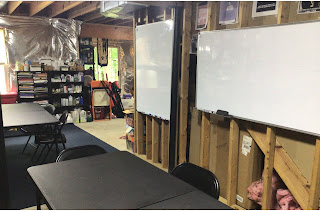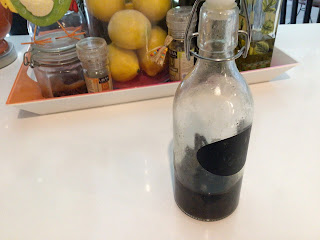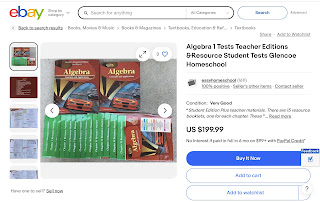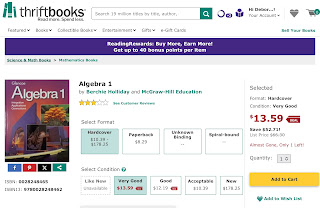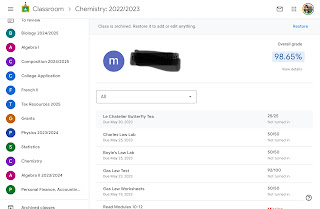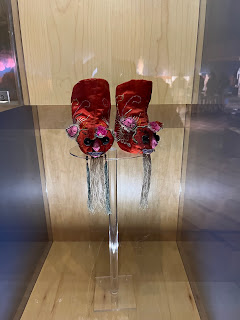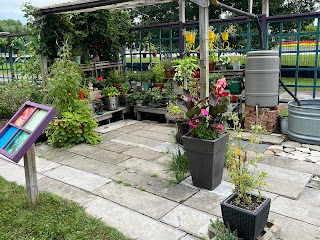The first day of class Composition is writing thank-you notes to service personnel. I had another idea. Why not have kids create note templates: thank-you, birthday, sympathy, etc? We might try AI to see what it generates. I’m going to have the kids create and label Google Drive files to save all of their work, too, for their high school transcripts. I want the kids to write genuine thank-yours to their moms as Christmas presents. I’m getting excited for Composition class!
Friday, August 30, 2024
Thursday, August 29, 2024
Co-op Space
Rob and I teach in our unfinished basement. We have loads of supplies because we teach several math, science, finance, and English classes. Loads. Below are some pix of the space. Rob and I have favorite stations. He wants a wall of white boards for problems. He took-over the mini white board to post assignments. I need table space for labs and supplies. The smaller, white board is usually enough. We set up two computers, too. One laptop is connected to an old TV for presentations. Rob prefers a large monitor; mainly he posts slide decks to follow as he instructs. Occasionally we teach different classes at the same time. This year, we are team teaching Biology and Algebra sequentially. Rob might help with my Composition class, too. Take a look at our classroom space.
Wednesday, August 28, 2024
M&M Math
Rob and I are planning material for Algebra I. Chapter Five has graphing. Our plan is to do some M&M Math. (This link has 212 pages of ideas.) We’re going to do the Percent Composition of M&Ms Lab. This is a great lab to introduce graphs, data analysis, and percent error. There is one caveat; the M&M color distribution varies. We’re using plain M&Ms. Here is an article explaining (eventually) that the color distribution has changed and is different depending on the M&M plant. Here is an article with the color distributions for minis, peanut, pretzel, dark, and almond M&Ms. I have no idea if these numbers are up to date.
What are we going to do? We’re going to give kids individual packages and one ounce samples from a big bag to count as homework. The kids will graph on paper and with a spreadsheet. I’ll post more when we get to the class. Candy makes for great labs! Kids get excited and retain more.
Tuesday, August 27, 2024
Get started on Christmas gifts!
I can hear you groan! Hear me out. I insist Paul make presents for Christmas. I’m an expert at five minutes gifts, such as home-made vanilla or rubs. A few of these projects can count as Art credit.
Paul likes to spray paint. We buy glass vases at the thrift store for him to paint. He’s building LEGO cherry blossom stems for the vases.
Monday, August 26, 2024
Join a Co-op!
I teach for the local Co-op, STARCH, outside Quantico. There are so many reasons to join a Co-op. Ours meets in May or June to plan for September. Mainly we plan course offerings; although, families have talked about courses and sequences for a year or more. But, Co-op is more than just class. Ours attends a home-school Mass together, followed by a trip to the park to play and have lunch. Families bring extra books, textbooks, math manipulatives, etc, to swap. Our Co-op plans to join the Catholic grade school for Holy hours monthly. The group joins forces with other Co-ops to host dances, bowl, or roller skate. Usually a mom know about discounts if people want to ski or go to a water park. STARCH share information in emails about opportunities at the Marine Corps Museum’s educational day. Some Co-ops take filed trips. My friend, Jen, belongs to two Co-ops, one in Woodbridge. That group takes overnight field trips to Luray Cavern or Beckly WV’s coal mine. See? The opportunities are endless. Ask friends about a Co-op near you!
Sunday, August 25, 2024
Measures
Many introductory science courses begin with measures. There are loads and loads of resources. General Science or Physical Science is a great time to teach measures well. Surprise! Start with a series of labs.
1. TEKS has this Measurement introduction. Read this first.
2. Metric Measurement has kids measure length, volume, temperature and mass.
3. Do a density lab. Here is my slide deck with Accuracy and Precision and Density. I use It’s All About Density. I have a jar with glass marbles, metal washers, metal cubes, lead fishing sinkers, corks, golf balls, etc. I distribute wooden blocks and index cards to measure, too. I have scales, cylinders, tape measures, yarn, calipers, and rulers to use to make measurements. The kids end up reviewing a few formulas for volume as part of the activity.
4. Measuring with Significant Figures has a few more activities, such as measuring the number of drops in one mL of water or locating some object on your body 1 mm long.
5. Try a few measurement worksheets: Measurements, Metric Conversion Worksheet, Metric Measuring Worksheets ( several grades), and Units and Conversions. We use this Metric Mnemonic, ‘Many Kids Have Dropped Over Dead Converting Metrics.’
Saturday, August 24, 2024
Algebra I Chapter 1 Slide Deck
Rob is still finishing Chapter 1 notes in a slide deck, here. He’s still working on the notes. He completed his Day One slides; however there are some personal information on it. I did take a screenshot of the first day’s class work. After I spoke to Rob, he explained that this slide is his book tour. So I made a worksheet instead. Here is the textbook tour worksheet.
Friday, August 23, 2024
Free Graphing Calculator
Desmos is a free, online, graphing calculator. Many schools use Desmos rather than TI 83/84 calculators. Here is an introduction to Desmos, which has the User’s Guide.
Algebra I Resources
In another life, I taught in both private and public schools. We had shelves loads with support materials. Publishers, such as Glencoe, produce loads of support material for teachers. Some of it is useful. Here is Chapter 1 Resource Masters. Scroll way, way down for the quizzes and tests. Keep scrolling to see the test answers. Here is the Chapter 1 Study Guide. Here is the homework guide. Here is a teacher’s study notebook. (Here is Mr. Hayden’s website. Here are the homework and study guide links for several levels of math. He has notes! Look at PEMBA.). Please note that the exercises coincide with even old textbooks. Algebra hasn’t changed much if you only consider the core material. I located most of the Chapter Resources for Algebra I, except for Chapter Two, which I just ordered along with the calculator supplement. You can buy these; the sets are pricey.
Why are you using older textbooks? Why aren’t you using Saxon for Algebra I?
Rob and I use older textbooks all the time to teach Co-op classes. (We bought used books whenever possible when we home-schooled Lacie and Paul, too.) The main reason for using older textbooks is that they are cheaper. In Algebra I we’re using the Glencoe series. (BTW there are newer editions nearly as cheap.). I wanted a math textbook with graphing calculator exercises and support materials, such as these resource masters. Why not Saxon Math? Saxon Math was fine for Paul. However, Lacie struggled for over a year with Saxon until I switched textbooks. Glencoe is widely used in the U.S. I think the material works well for most students.
Algebra I: Follow Along!
My husband, Rob, is teaching Algebra I. My plan is to post his assignments and slide decks here for you. We ordered teacher textbooks for each family along with student textbooks. Families have the resources at hand to grade homework and look for solutions. Rob teaches Math and Physics for the local Co-op. My job is to help students who are struggling; I have experience working with kids who have profound learning differences. Some of you may find these resources helpful. The textbook has pacing guides. We meet twice a week, 1 1/2 hours each session. All homework and tests are finished at home. We have study time after lunch twice a week (after class) for questions and extra help. We hope to have 65 sessions; class time is laser-focused on Algebra instruction. He and I are researching every topic for relevancy to Algebra. For example, why does Algebra include stem and leaf plots? Here is the best answer I found. Consequently, we’ll introduce and practice a few stem and leaf problems for exposure, and then move on with instruction. Here are the textbooks and first few assignments.
Monday, August 19, 2024
Intro to Graphing Calculator
The Algebra 1 class is going to learn how to use a TI 83/84 graphing calculator. Below are pix of the summer assignment from the Glencoe textbook. The older algebra textbooks have more graphing exercises integrated into the textbooks; newer versions assume the instructor is experienced with the graphing calculator and doesn’t include as many instructions. We’re doing extra exercises, too. Take a look!
Saturday, August 17, 2024
Scavenger Hunts
Rob and I just traipsed through several museums and gardens on vacation. Many had scavenger hunts. It helps young children navigate a museum if it’s more interactive. So I looked for more scavenger hunts. Since I live outside Washington D.C., it seems like the logical place to start. The Smithsonian Air and Space Museum uses Goosechase; instructions for the Air and Space Museum’s Scavenger Hunt guide visitors through the process. The NGA in Your Neighborhood is a scavenger hunt which ties the building and grounds to one’s own neighborhood. Are you planning a visit to the African American Museum (NMAAHC)? They have more of a study guide. The Constitution Scavenger Hunt with Political Cartoons from the National Archives is more of a lesson, too. Here’s the hunt from the Natural History Museum. Here’s the American History Scavenger hunt. Instead of a hunt, the National Building Museum has Patterns, a 38 page educator’s guide. America’s Presidents is a classroom resource from the National Portrait Gallery, one of our family’s favorite museums. The Smithsonian also has Adventure Lab. (I haven’t tried the app, yet.). One more hunt, The National Zoo. (We just visited the Corning Museum of Glass, which has several scavenger hunts, all available online and at the museum.)
Thursday, August 15, 2024
Why use Google Classroom?
ob and I teach several classes. We keep records in Google Classroom. (Rob keeps a separate spreadsheet for grades, too. Several families use one email; the children are discouraged from using electronics. Yes, it’s a pain. However, the parents are serious about monitoring computer use. Good job!). Why bother? I like to post assignments to Classroom. If a kid is out sick, the material is there. I use Classroom as an organizational tool. I can prep lessons in advance and save interesting ideas in Classroom.
However, when I was home-schooling individual kids, Classroom was even more useful. I created a class for each subject and keep track of completed assignments. You can take a photo and upload it to Classroom. For example, snap a completed and graded quiz, open Classroom, select the class, and upload the photo under the graded assignment. Better still, have your child upload the photo. Everything is saved and organized. It is so much easier to prepare digital portfolios for submission to online schools. Google Classroom keeps a record of grades. I take screenshots of these averages, too, for the portfolio or quarterly reports.
Long term, Google Classroom is useful for transcripts, too. I just received a request for a transcript from a Chemistry class held two years ago. I archive each year’s classes. It’s easy to reopen archived classes and retrieve the records. Keeping records is more work up front and less aggravation in the long term.
Tuesday, August 13, 2024
English
I’m teaching Composition this year and decided to buy English textbooks. I bought used copies of an older, eighth grade textbook. The content is good, about half basic grammar and half the writing process. The class is small, which is great; all of the students need to work on basics. Two of the first writing assignments are a personal narrative and a friendly letter. The format dove-tails well with my plans. I want the kids to write to active duty military members and describe their birthday celebrations. Below is a sample from the table of contents. It isn’t the entire course; however it is a good start!
Monday, August 12, 2024
Visit Off-beat Museums!
We just returned from Toronto and visited several museums, including a few off-beat ones: Corning Museum of Glass, the Bata Shoe Museum, the Textile Museum of Canada, the National Comedy Center, and the Luci Desi Museum. Corning Museum of Glass is in Corning, NY; the Comedy Museum and Luci Desi Museum are in Jamestown, NY. If you watch old ‘I Love Lucy’ TV shows, you’ll enjoy the Luci Desi museum.
Our family makes it a habit to visit odd museums, such as The Électrium, the Health and Medicine Museum, or the National Building Museum. (During one visit to the National Building Museum, my son said he would like to see the display of chairs and couches.). We’ll hear of a museum and say, ‘That sounds different.’ and plan a visit. Off-beat museums tend to appeal to kids. The Bata Show Museum has everything from historic foot ware to sneakers. Bata has an amazing area for kids, including a shoe, dress-up area. We just like to be surprised. Many, many times, the off-beat museums are full of fun!
Friday, August 9, 2024
Visit a Garden!
Rob and I just visited the Royal Botanical Garden (RBG) in Ontario. Gardens provide many sources of inspiration. Look at their Children’s programs. During our visit, a docent was explaining how to repot plants. RGB has a large natural playground. Plan ahead to see what amenities and activities are available. Plan a picnic or look for a nearby playground to visit after the garden tour. Look for free tours. When we lived in Winchester, the Glen Bernie Gardens were open for free tours at least once a year. Blandy Experimental Farm, an Arboretum, nearby, has free tours. Colleges, such as Clemson’s SC Botanical Garden often have free garden tours. Try a few, small garden tours to see if your family likes these visits before you tackle a big garden, such as Longwood Gardens or The Washington State Arboretum.


